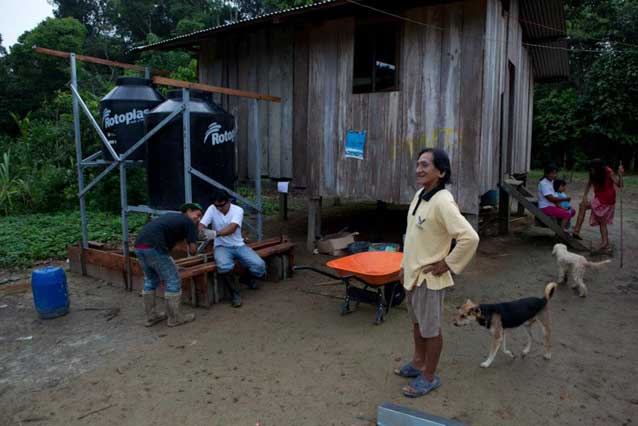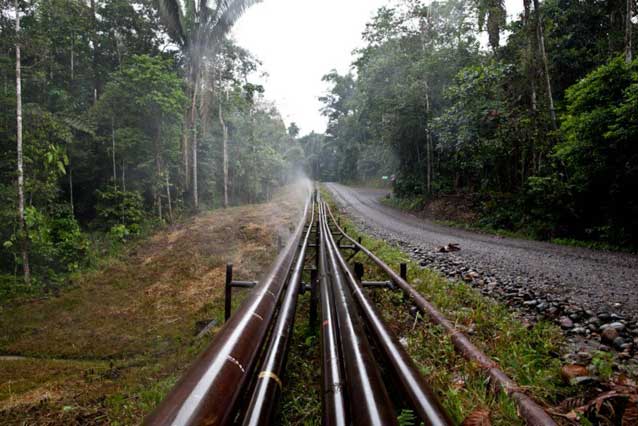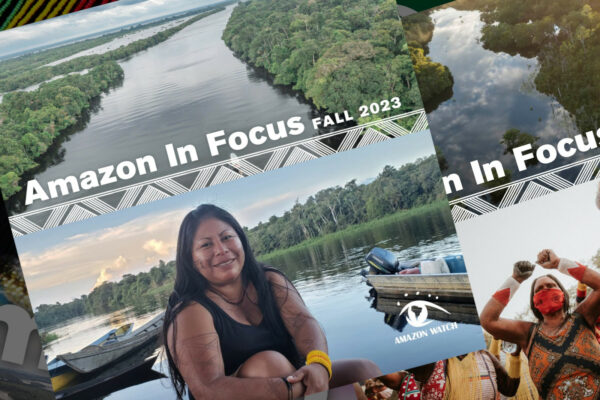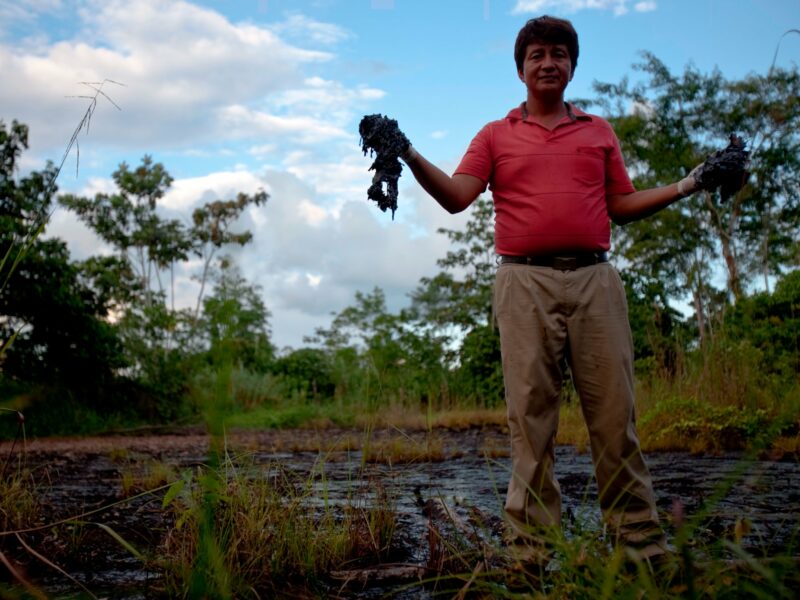
Support ClearWater!
Become a ClearWater Champion
and give 100% to clean water solutions in Ecuador.
It’s a long trip from the Amazonian city of Coca to the Waorani community of Yawepare on the edge of Yasuní National Park in Ecuador, much longer than the actual distance would seem to indicate. After almost an hour at high speeds along a paved portion of the Via Auca, the first road in the region built by Texaco when the company initially began operating in the area, you turn off onto the Via Pindo. From there, it’s another hour or more on a rocky, unpaved road that snakes through the jungle passing oil stations, platforms, gas flares, and mestizo, Kichwa, Shuar, and Waorani communities. Out here you’re a long way from Coca. It was in this area, specifically in the mestizo community of Los Reyes, where, in 2009, a woman and her family were attacked and killed by the Tagaeri, one of the two Waorani subgroups living in voluntary isolation in the Ecuadorian Amazon. When you’re out here it’s almost unfathomable to look around and imagine these uncontacted indigenous groups, people of an ancient culture still living in the most traditional ways, in such close proximity to modernized communities and large-scale oil activity. That’s the reality of uncontacted groups in Ecuador today. There is very little space left in the forest to roam, and every day it gets smaller.
About a week before we arrived in Yawepare, the Taromenane, the other uncontacted Waorani group, attacked an elderly Waorani couple just outside of the community of Yarentaro. Before killing Ompore and his wife Bogueney, the Taromenane expressed their anger at the destruction of their forest home: the noise, the logging, the construction of roads, the settlers, and the oil platforms. They said that the contacted Waorani had not done enough to prevent this incursion on their lands, and that the Waorani would have to pay. You can read a statement on the attack here. Understandably, this event sent a shockwave through many Waorani communities who fear continued attacks from their uncontacted brethren. I was curious to get a read on the feelings in Yawepare related to this incident, aware, nevertheless, that this could be a difficult subject to approach.
I was accompanying Mitch Anderson, former Amazon Watch corporate accountability director and the current international director for the ClearWater project, on a trip to Yawepare to install 13 rain catchment systems in the community, three of which would be installed in the neighboring community of Nampa Eno. ClearWater is a community-based project, supported by Amazon Watch and a collaborative network of organizations and foundations, that is providing clean water drinking systems to hundreds of affected families among the indigenous nationalities in the oil-affected region. The work in Yawepare constitutes a pilot project for ClearWater: both as the first time utilizing a new structure for the systems made of metal – a bit more costly but that lasts over five times longer – and as the first time working with the Waorani. I was very excited to be able to participate in this project and to return to Waorani territory after nearly two years.

As we pulled in to Yawepare we were greeted by the standard barking dogs, and also by an older Wao man, Ocata, who spoke almost no Spanish but whose eyes welcomed us with tenderness. Ocata is Moipa Nihua’s father. Moipa is the current president of ONWO, the National Waorani Organization of Orellana, and was the primary contact for working in Yawepare. Moipa helped organize the families receiving rainwater units, the men who would participate in the building of the systems, and the food provided to those who worked. His father, Ocata, was born prior to contact and is still known as one of the best hunters among the Waorani. We would spend hours with him, while Moipa translated, asking him stories of his life and of the days before contact. When asked what he thought about the Taromenane attack, and whether he feared for his community’s safety, he said no. He said he would really like to meet them and see some of his old relatives again.
For the next few days, we worked with Yawepare community members under the direction of Eduardo Cuji, a Kichwa man from Rumipamba hired as the lead technician for the Yawepare and Rumipamba installations. ClearWater operates from a community-based model. Every community, or set of communities, provides two local technicians who have been trained in the installation and maintenance of the rainwater systems. Local technicians can effectively organize within their own communities, and the training they receive allows them to lead the project installation. The project is not a top-down gifting of rain catchment systems as has been done in the past. Local technicians are a fundamental element of the ClearWater model; they are the face of the communities working to improve their own situations. Unfortunately, the two Waorani technicians from Yawepare disappeared the week we were supposed to be working in their community. This meant that Eduardo had to be contracted to lead the construction of the units. The positive side of this is that Eduardo is highly capable and respected by the Waorani. He was a successful lead technician who organized effective work teams on the ground that made swift progress.
There are three phases in the initial construction of rain catchment systems. First, cement bases have to be laid. This requires constructing wooden frames of equal length and height, while compensating for uneven ground. These frames are filled with rock and cement. They become the bases within which the legs of the metal system frames are placed. The counterparts, that is, the families receiving the unit, are expected, per agreement, to provide the wood for the frames and the dirt and rock that is mixed with the cement, which is provided by ClearWater.
Once the bases are constructed, the next phase is the assembly of the metal frames of the system. All the metal parts, screws, lug nuts, nails, giant plastic containers that hold the water, and tools have to be transported into the communities, directly to the homes where the systems will be built. As one might imagine, this can border on a logistical nightmare, especially with some communities and households that are hours down river, where the only mode of transport is canoe. Getting all of the supplies to Yawepare had its share of complications, but fortunately when it came time to build we had everything we needed for the initial system construction; the roofs were another story. With Eduardo as lead we worked to construct the metal frames and place them in the cement bases. When finished, I have to say they really looked good and solid, and I didn’t even see them with the finished roofs. The final step of the initial unit construction is the roof that covers the water tanks and metal canals that run from the roof of the home to the tanks. When it rains, water runs from the roof of the house through the canal, filling the filter tank and passing through a filter pipe into the larger tank where it is stored. From there it comes out of a spout for easy use in all household activities.
After working for a few days in the community of Yawepare I couldn’t help but notice a generally positive demeanor among the workers and families. I have spent some time with the Waorani and know them to be a very positive people in general – and I know it helped that 7 wild peccaries had been hunted the day before so everyone was well fed – but it was clear that people were genuinely excited about the project. This is a project that has sprung out of meetings between the five indigenous nationalities in the region in which their needs and desires were the topic of discussion. The desire for clean water was the overwhelming response from communities of all five nationalities; thus, ClearWater was born. It was an emotional experience watching a project unfold that directly benefits families affected by Chevron’s toxic legacy in the Amazon – a project in which the families themselves feel ownership of the progress being made, after 20 years in a lawsuit that has certainly raised awareness to their precarious health situation and made it possible for a project like ClearWater to exist, but that really, up to now, has given these families very little to show on the ground for their extraordinary efforts to bring a giant transnational corporation to justice.
Sadly, I was not able to witness the completion of construction of the 13 units in Yawepare. About 4 days in to building I came down with a serious fever. I spent several days laid up in a hammock in a traditional Waorani house, going between severe chills and sweats, and body aches and pains. I decided to leave Yawepare for Coca on Monday to get some blood tests done. It turns out I contracted dengue fever, so that was the end of my time in Yawepare, for now. I will return in a couple of months to see the finished systems and I really look forward to participating in future installations in the territories of all five nationalities involved in the project. ClearWater is one of those projects that, as someone who works in the areas of indigenous rights and environmental conservation in the Amazon, you don’t see often enough. It’s a rare project that comes directly out of indigenous communities, strengthens and empowers them by providing them with the tools and skills to improve their own situations, while reinforcing their right to free determination over their own lives and wellbeing.















